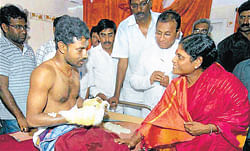Of poor track record and putting politics before people
The fire accident involving the Tamil Nadu Express last week has once again brought to the fore how unsafe our rail journeys are. A look at the data on accidents reveals that mishaps involving level crossings and collision of trains are less in number but kill more people. Collisions constitute only seven per cent of total accidents on tracks but claim 38 per cent lives, and is the second biggest killer because of the absence of a fool proof medical assistance mechanism post-accidents. Level crossings, however, are the biggest killers and account for 46 per cent of deaths in train accidents. Derailments are frequents and, according to the data, cause over 55 per cent of accidents but claim not more than 10 per cent of lives.

A corporate safety plan put in place in 2003 and effective till 2013, identified over-aged tracks, recommended elimination of four-wheeler tank wagons which are accident-prone and thermit welded joints. It set a target to reduce derailments by 16 per cent. The plan also recommended improved training facilities for enhancing human skills to combat the problem.
Though fire on trains has never been a frequent occurrence, the Tamil Nadu Express accident exposes the vulnerability. Fire accidents constitute only a minor percentage of the total accidents and account for equally less percentage of fatalities. However, the corporate safety plan recommended adoption of fireproof coaches and fire retardant material in the existing coaches. But, the scheme implementation is too slow to make all railway compartments fire safe before the scheme ends.
The report of the Comptroller and Auditor General (CAG), 2012 points out weaknesses in our effort to combat collisions. It has evaluated two major equipment, Anti-Collision Device (ACD) and Train Protection Warning System (TPWS) that the Railways is installing to eliminate accidents caused by human error. the much talked about Anti-Collision Device or Raksha Kavach, has been found to be technically deficient during trials.
“The continuing deficiencies on various safety counts had not been fully evaluated by RDSO/Railway Board with reference to the system design that needed to be addressed on priority for satisfactory resolution for enhancing safety,” says the CAG report. Similar comments have been made about TPWS: “While the results of TPWS trials over NCR were still under evaluation and those of Southern Railway were found below acceptable standards; audit found that Railway Board had sanctioned (in 2010-11) TPWS work on other zones.
However, railways are relying on these devices and going ahead, but their installations too is slow.
The High Level Safety Review Committee headed by Anil Kakodkar recommended elimination of around 15,000 unmanned level crossings in five years. It wanted only the Railways to undertake this task and do away with the involvement of state governments. But, its implementation does not seem feasible given the resource crunch the Railways is currently facing.
The Committee not only recommended a comprehensive upgradation of everything, right from tracks and signaling equipment to bogies, together with improvement of human skills - the biggest factor in train accidents.
However, Railway Minister Mukul Roy is not keen on implementing the report as Kakodkar Committee was constituted by his predecessor Dinesh Trivedi. Safety is only a declared policy, but political considerations overrule everything!
Related Stories
Rail safety under spotlight
Deccan Herald is on WhatsApp Channels| Join now for Breaking News & Editor's Picks